Customers Generally Happy
With Automotive Industry
Although customer satisfaction
remains steady for the automotive industry, according to
the American Customer Satisfaction Index, individual car
companies that once thrived are waning.
For the fourth consecutive year, the automotive industry
matched its ACSI record score of 80 (on a 100-point scale).
Among individual car companies, however, there are several
significant changes. Hyundai continues its climb in customer
satisfaction from an industry-low score of 68 in 1999 to
81 this year. Cadillac remains at the top with a score of
87, followed by BMW with 85, Toyota with 85 and Buick with
84. Pontiac and Volkswagen, which each dropped 7 points
from last year, fared lowest with 76 points.
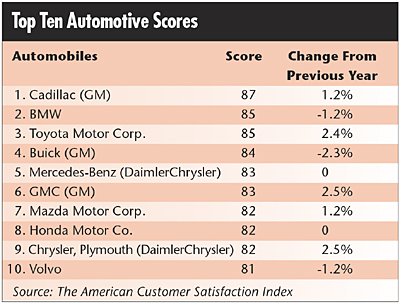
“With sales and quality lagging in the past, Cadillac
seems to have now hit its stride with gains in sales and
a customer base no longer at or near retirement age,”
says Claes Fornell, director of the University of Michigan
Business School’s National Quality Research Center,
which compiles and analyzes the ACSI data. “As Cadillac
reaches younger and more affluent customers, the importance
of satisfaction and buyer loyalty will take on new significance.”
Jack West, past president of the American Society for
Quality and co-sponsor of the ACSI, says the gap in customer
satisfaction between a company like Cadillac and a company
at the bottom, is shrinking.
“Throughout the 1990s, the difference between the
top and bottom automakers in the ACSI was 18 or 19 points,
but in the last four years, it’s been no more than
a dozen points,” he says. “This shrinking differentiation
is even more pronounced when comparing domestic car companies
with European and the Japanese companies, which are now
back on top in customer satisfaction--but not by much.”
The ACSI is a national economic indicator of customer
evaluations of the quality of products and services available
in the United States. It’s updated quarterly with
new measures for different sectors of the economy replacing
data from the previous year.
Overall customer satisfaction, which has moved steadily
upward for the past two years, remained constant last quarter.
Following a first-quarter surge of 1.2 percent to a score
of 73.8, the ACSI was unchanged for the second quarter.
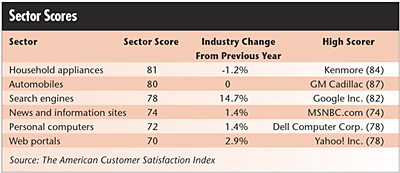
“Although a climb may be preferred over a stable
index, the ACSI improvements over the past 21 months cannot
be dismissed by a three-month halt,” suggests Fornell.
“From the perspective of the economy’s capability
to generate buyer satisfaction, the outlook must be viewed
as moderately encouraging.”
During the second quarter, four manufacturing durables
industries were measured: automobiles, household appliances,
consumer electronics and Internet e-business (i.e., Web
portals, search engines and news sites). Only household
appliances showed a decline in customer satisfaction. However,
with a score of 81, it’s still nearly 10 percent higher
than the aggregate ACSI for all industries. Kenmore, the
most popular brand, topped the industry with a score of
84, followed by Whirlpool (82), General Electric (81) and
Maytag (81).
Among PC companies, Dell leads the way for the sixth straight
year, with an ACSI score of 78. Apple, up six percent, is
right behind with a mark of 77, and the fall of Gateway
continues--its 69 score is down 12 percent from its peak
of 78 in 2000.
“In a market dominated by Dell and Hewlett-Packard,
Gateway faces a difficult challenge,” notes Fornell.
“Service expertise, which used to be Gateway’s
strength, has seen better days, according to customers.
The company has reported negative net income and falling
revenue the past five quarters.”
Overall, the e-business score jumped four percentage points,
from 68.7 last year to 71.4 this year. Among portals, Yahoo!
scored highest in customer satisfaction, with a mark of
78, followed by MSN (74) and AOL (65). The latter bettered
its score by 10 percentage points, a rise that can largely
be attributed to an improved home page and software, major
upgrades in virus protection, and better messaging capabilities
and e-mail services, Fornell says.
In the search engines category, Google continues to dominate
with an ACSI score of 82, compared with Ask Jeeves’
69 and Alta Vista’s 63. Among news and information
sites, the collective ACSI score was 74.
To see all the scores and to read more commentary by Fornell,
visit www.theacsi.org.
Countdown to ISO 9001:2000 Transition
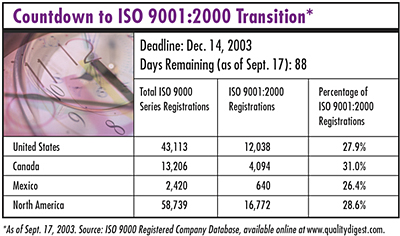
Baldrige Supporters Push for Not-for-Profit
Category,
End to Award Cap
Members of the National Baldrige
Coalition, a group of supporters of the Malcolm Baldrige
National Quality Award, have recently stepped up efforts
to achieve two longstanding goals: expanding the award to
include a not-for-profit category and eliminating the cap
on the number of awards.
Because the Baldrige National Quality Program is established
as a law (Public Law 100-107), any changes to the program
must be made legislatively. A letter signed by more than
400 Baldrige supporters was delivered to senators John McCain
and Ernest Hollings and representatives Sherwood Boehlert
and Ralph Hall, the chairs and ranking members of the authorization
committees for the National Institute of Standards and Technology
in both the Senate and the House of Representatives.
Signers of the letter include former Baldrige Award winners,
examiners, overseers, judges and Baldrige Foundation board
members, all of whom want to make it possible for not-for-profit
organizations to apply for the national award.
The effort will concentrate on achieving authorization
for the changes in fiscal year 2004 and funding to implement
the changes in fiscal year 2005.
There are currently three types of not-for-profit organizations
not currently eligible to apply for the award. They are:
 Public agencies of federal, state and local governments
Public agencies of federal, state and local governments
 Independent-sector, private not-for-profit organizations,
such as human service, religious, cultural or trade, and
professional associations
Independent-sector, private not-for-profit organizations,
such as human service, religious, cultural or trade, and
professional associations
 Quasi-public organizations created by legislative authority,
such as public utilities, cooperatives, mutual insurance
companies and credit unions
Quasi-public organizations created by legislative authority,
such as public utilities, cooperatives, mutual insurance
companies and credit unions
Another concern is the cap on the number of award winners
per category per year. The letter asserts: “If Congress
acts to eliminate the caps, you will help to avoid the potential
travesty of having a worthy organization denied an award
for the sole reason that it was one of more than three applicants
in a given category that the Baldrige judges determined
met the standard of excellence represented by the award.
As long as the cap exists, this possibility exists.”
To view the letter in its entirety, visit www.asq.org.
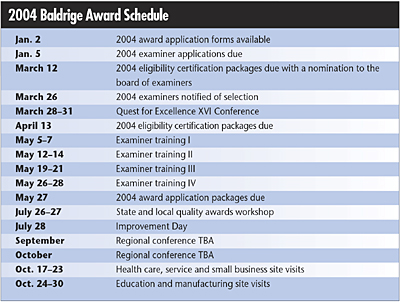
Building Homes on a Foundation of Quality
When D.R. Horton, a home building
company in North Carolina, decided to improve quality throughout
the organization, it wanted to ensure that its partners
would do the same. So, the company turned to the National
Association of Home Builders’ Research Center.
Known as America’s housing technology and information
resource, NAHB Research Center, a subsidiary of the National
Association of Home Builders, provides product research
and building process improvements that have been widely
adopted by home builders in the United States.
In 1991, the NAHB Research Center introduced the National
Housing Quality Certified Trade Contractor program. A certified
builder program was initiated in late 2002 with funding
assistance provided by the public-private Partnership for
Advancing Technology in Housing program, which is administered
by the U.S. Department of Housing and Urban Development.
After requiring that its trade contractors become certified,
D.R. Horton reaped the benefits of the quality improvement
initiative. “We saw improvements in job site readiness
throughout the construction process, a remarkable improvement
in the general quality of individual contractors’
work and an improved overall attitude,” recalls John
Nance, vice president of construction and warranty for the
Central Carolina division of D.R. Horton. “Our trade
contractors seemed to have an increased sense of pride and
ownership of their work after completing the training and
starting the certification process.”
Certification training through the NAHB Research Center
consists of three one-day training sessions, spaced a few
weeks apart. The process focuses on areas of the contractor’s
business practices that need improvement and helps develop
the tools necessary to exceed in customer satisfaction.
Certification is achieved after three months of operating
the quality system. Companies must pass a certification
audit and then be audited annually to maintain certification.
Audits include an examination of the company’s systems
and a job site inspection.
The NAHB Research Center Web site offers a searchable
database of certified contractors. Also available are an
insulation contractor certification program, quality management
resources, and information on the National Housing Quality
Award. To learn more about NAHB Research Center and its
programs, visit www.nahbrc.org/quality.
Employees in “Rational Endurance”
Mode
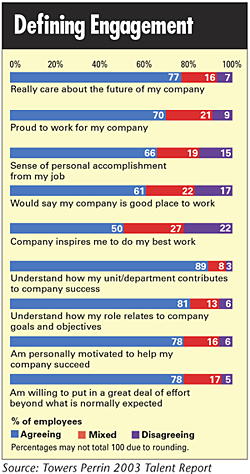 U.S.
workers remain focused on their jobs despite the tough economic
climate, job layoffs and other business challenges of the
last two years, according to recent research from Towers
Perrin. Employees of medium-sized to large organizations
are in a mode of “rational endurance”--doing
what is required to help keep both themselves and their
companies afloat. However, the study also shows that relatively
few of the employees surveyed exhibit high levels of engagement
in their jobs. U.S.
workers remain focused on their jobs despite the tough economic
climate, job layoffs and other business challenges of the
last two years, according to recent research from Towers
Perrin. Employees of medium-sized to large organizations
are in a mode of “rational endurance”--doing
what is required to help keep both themselves and their
companies afloat. However, the study also shows that relatively
few of the employees surveyed exhibit high levels of engagement
in their jobs.
“Employees are getting the job done, which has a
lot to do with a sense of enlightened self-interest on their
parts,” says Charlie Watts, head of Towers Perrin’s
Organization and Employee Research consulting practice.
“But their resiliency doesn’t equate with true
engagement. Engagement, which we define as employees’
willingness and ability to contribute to company success,
ultimately comes down to people’s desire to give discretionary
effort in their jobs.”
The bulk of employees surveyed are only moderately engaged,
according to the study. In fact, only a small percentage
are highly engaged, meaning they’re both willing and
able to invest an extra level of discretionary effort that
separates outstanding performers from others.
“Working Today: Understanding What Drives Employee
Engagement, the Towers Perrin 2003 Talent Report”
drew responses from more than 35,000 employees in the United
States.
The study identifies a list of workplace elements that
are critical in building engagement among employees, including
strong leadership, personal accountability, autonomy, a
sense of control over one’s environment, and opportunities
for advancement.
Another finding is that a highly engaged workforce is
likely to be more stable. Two-thirds of highly engaged employees
have no plans to leave their current jobs, vs. 36 percent
of the moderately engaged and only 12 percent of the disengaged.
The research identifies a set of attributes that, in combination,
are critical to building high engagement. It also tells
employers how workers think they’re doing in each
of these areas.
“The key for employers is to understand which employees
are most critical to the organization and then determine
their levels of engagement,” Watts notes. Learn more
at www.towersperrin.com.
INDUSTRY NEWS
A July 22 article in the New
York Times reports that many retailers are banking on quality
to sell during the “back-to-school” season.
“Back to School Survival: Sales are Thin, Customers
Bored; It’s time for ‘Quality’”
points to an emphasis on upgraded fabrics and more stylish
merchandise. One retailer of children’s clothing is
offering improved fit and softer washes on jeans at the
same price as last year. A shoe manufacturer is adding more
moisture-control material in its athletic shoes. “Merchants
have little choice but to deliver more and better merchandise;
increasingly, they concede, the old formulas are not working,”
the article states.
The Association for Quality
and Participation, an affiliate of the American Society
for Quality, is gearing up for another year of its Team
Excellence Award program.
The Team Excellence Award offers international recognition
for an organization’s team-based improvement efforts.
Nominees are judged against 36 team evaluation criteria.
Finalists will be selected for live presentations at a joint
AQP/ASQ conference, slated for next year. The updated timeline
is as follows:
The due date for team entries--a 25-minute video presentation
and documentation--is Dec. 12. Preliminary round entries
will be judged during January and February. The joint AQP/ASQ
Quality Congress will be held May 22–26 in Toronto.
Learn more at www.aqp.org.
Nikon Instruments Inc. has
released the latest model in the NEXIV line of measuring
instruments, the NEXIV VMR-H3030. Touted by Nikon as the
fastest, most precise video measuring tool available, the
VMR-H3030 serves as a laboratory’s master measuring
instrument. Utilizing the newly released VMR-Z120X maximum
magnification module, a dual optical system, the VMR-H3030
offers stage scale resolutions enhanced to 0.01 µm
and wide-illumination options to ensure precise edge detection
in complex parts.
The VMR-H3030 manages a range of inspection duties, including
NEXIV’s through-the-lens laser focusing system, allowing
users to scan 1,000 points per second on complex profiles
of 3-D precision parts. The NEXIV VMR system also features
a 15¥ telecentric zoom system to facilitate searches
at low magnification. For more information, visit www.nikonusa.com.
Rockwell Automation has launched
a new manufacturing performance assessment program. The
new line of assessment tools identifies opportunities for
process improvement in maintenance, repair and operations
practices. The MPA programs also identify performance issues,
establish baseline metrics and outline recommended corrective
actions.
The assessment components include machinery condition
evaluation, plant baseline evaluation, installed base evaluation
and integrated performance tools. “Many manufacturers
rely on intuition and experience and assume their processes
are designed well enough to meet production goals,”
says Mike Laszkiewicz, vice president of asset management
for Rockwell. “By assessing the maintenance and engineering
process, surrounding activities and supporting resources,
we can identify the factors that are inhibiting equipment
and operator performance.” For more information, visit
www.rockwell.com.
In an attempt to encourage
information sharing among the Six Sigma community, the International
Society of Six Sigma Professionals now offers the iKnow
Knowledge Network. The network is an advanced collaborative
information repository designed to deliver comprehensive,
credible Six Sigma information to ISSSP members online.
The network will deliver information from a range of Six
Sigma disciplines and will include articles, information
about useful books, video, audio and PowerPoint presentations,
white papers, press releases and industry news, notes from
roundtable discussions, focused session archives, upcoming
event updates, and case studies. Learn more at www.isssp.com.
The American Society for Quality
has launched its online Career Center on the organization’s
Web site. The Career Center offers access to employers and
jobs in the quality industry and provides support to job
seekers. Anyone may view job postings for free, and ASQ
members may post résumés on the site. Organizations
interested in posting a vacant position may do so for $200
per month for each listing.
Individuals who have posted a résumé on
the site to receive weekly updates of the new jobs added
that match the search résumé criteria specified.
The site also features four curriculum programs consisting
of a set of core courses and a series of electives, including
ASQ’s quality management specialist, quality engineering
specialist, quality technician specialist and quality auditor
specialist curriculum. For more information, visit the Career
Center at www.asq.org.
|